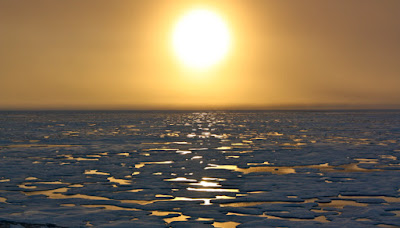To summarise all the issues in this blog, I thought it would be useful to venture back to the set of questions I posed at the beginning.
What is the evidence for anthropogenically-induced climate change in the Arctic?
I started off by investigating whether recent environmental changes are part of natural cyclicity or an emblem of anthropogenically-induced climate change. The multiproxy approach of McKay and Kaufman (2014) to reconstructing the last 2000 years of Arctic summer temperatures indicated the anomalous nature of recent warming compared to past variability. While, the climate reconstruction based on algal pigments, diatoms and stable isotopes by Florian et al. (2015) revealed similarities between modern-day conditions and those experienced during the Holocene Thermal Maximum (HTM). In addition to climate, confounding factors (e.g. nitrogen deposition) have further altered lake ecology from that recorded during the HTM.
Even in the last century, Arctic temperatures have fluctuated significantly. While internal variability appears to be largely responsible for early 20th century warming event (ETCW), external forcing inducing a negative NAO phase has led to recent warming in Greenland and northeastern Canada. Feedback mechanisms, in addition to orbital forcing, have determined Arctic climate and external forcing of climate from increasing greenhouse gas emissions is likely to dominate future climate.
 |
| Surface temperature anomaly map of temperatures in Nov 2016 compared to those from 1951-80 (NASA, 2016) |
In what ways is increased atmospheric CO2 impacting arctic environments?
Climate change is altering Arctic environments at a range of spatial and temporal scales. Primary productivity in Arctic lakes has responded quickly to declining ice cover, increased turbulence and enhanced nutrient cycling. Diatom assemblage turnover has been significant during the 20th century with clear shifts towards small-celled planktonic diatoms. In contrast, shifts in terrestrial environments, including the advancement of tundra into polar deserts and northward boreal forest expansion, occur at a slower rate and exhibit lagged responses.
 |
| Earlier sping melting and glacial discharge into Mendenhall Lake in Alaska |
Significant mass loss of the Greenland Ice Sheet has occurred forming supraglacial lakes, releasing vast quantities of freshwater, exporting nutrients and contributing to increased atmospheric CO2 through a positive feedback mechanism. In addition, permafrost soils are increasingly being transformed from a carbon sink to a source through enhanced organic carbon erosion and mineralisation into CO2 and CH4 by the combined influence of active layer deepening and thermokarst creation. However, there is also the potential for parts of the High Arctic to become strong carbon sinks through shifts in species assemblages, counteracting the expansion of lower latitude C source regions.
Enhanced atmospheric CO2 levels is also contributing to acidification of the Arctic Ocean leading to reductions in aragonite, alterations in the N cycle and significant effects on marine ecosystems.
Enhanced atmospheric CO2 levels is also contributing to acidification of the Arctic Ocean leading to reductions in aragonite, alterations in the N cycle and significant effects on marine ecosystems.
To what extent do confounding factors play a role?
Arctic environments are far from pristine in terms of the amount of pollution that threatens its unique ecosystems. A combination of acidification, heavy metals, POPs and more recently nitrogen deposition have been responsible for ecological degradation across the region. It appears that a combination of climate change and pollution has synergistically driven shifts towards new ecological states that have not been recorded in the Holocene.
 |
| Nickel foundry in Norilsk, western Siberia belching out smoke containing sulphur dioxide |
What does the future look like for the Arctic and the rest of the world?
Significant changes are taking place in the Arctic and, as suggested in the Arctic Resilience Report, there are a number potentially irrevocable tipping points that we may have passed or will exceed soon. According to Overland et al. (2013), a seasonally nearly ice free Arctic Ocean is likely before 2050 in response to increasing temperatures of up 13°C for a business-as-usual emission scenario. However, the numerous difficulties and uncertainties in projecting future temperatures and sea ice extent must be considered when interpreting such results.
The positive feedbacks resulting from climate change in the Arctic, including sea ice loss, melting permafrost, sea level rise, alterations in atmospheric and oceanic circulation, and vegetational shifts, will affect global climate. However, the complexity of interacting drivers and feedback loops make the extent of future warming difficult to predict.
Climate change in the Arctic
I hope that after reading this blog that when talking about climate change in the Arctic much more comes into mind than merely melting sea ice and glaciers. From changes in plant-ecotonal boundaries to permafrost degradation, Arctic systems are responding through a number of complex interactions, connections and feedbacks.
Personally, the rate of change has been surprising, particularly with regard to diatom community compositional changes, and the melting of sea ice and the Greenland Ice Sheet. Throughout the blog I have also increasingly recognised the many uncertainties and complexities in climate reconstructions, projections, and evaluating the type and extent of response.
What's most important to realise is how these alterations, in a region remote from anthropogenic activity, signify the impact we as humans are having on our planet. Human activity is playing an ever-increasing role in influencing the functioning of the Earth System and will continue to determine the expression of future global change. Alterations in the Arctic are a warning sign to act upon as the many potential positive feedbacks could lead to uncontrollable warming. Following a year in which numerous climate trends have been broken, the need for global action in combatting climate change is more apparent than ever.
 |
| How will the melting North respond to climate change into the future? |















